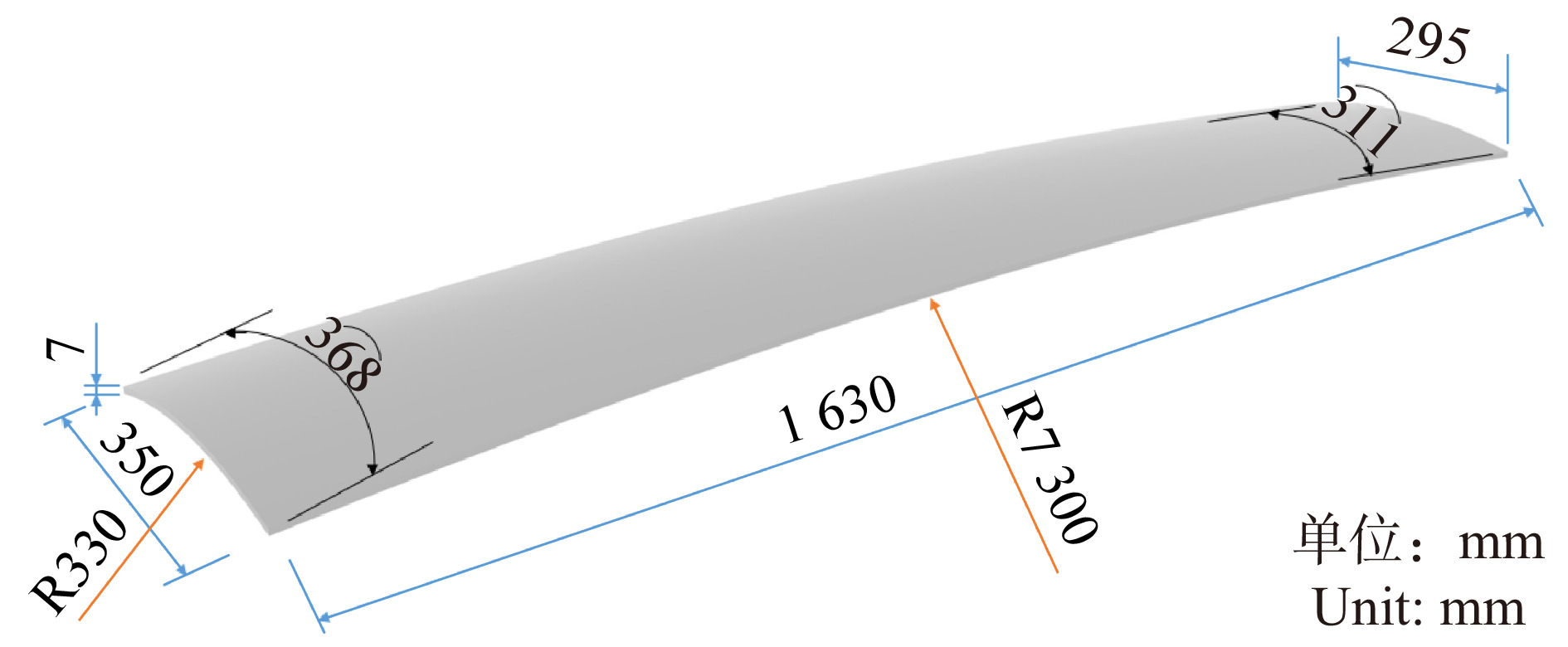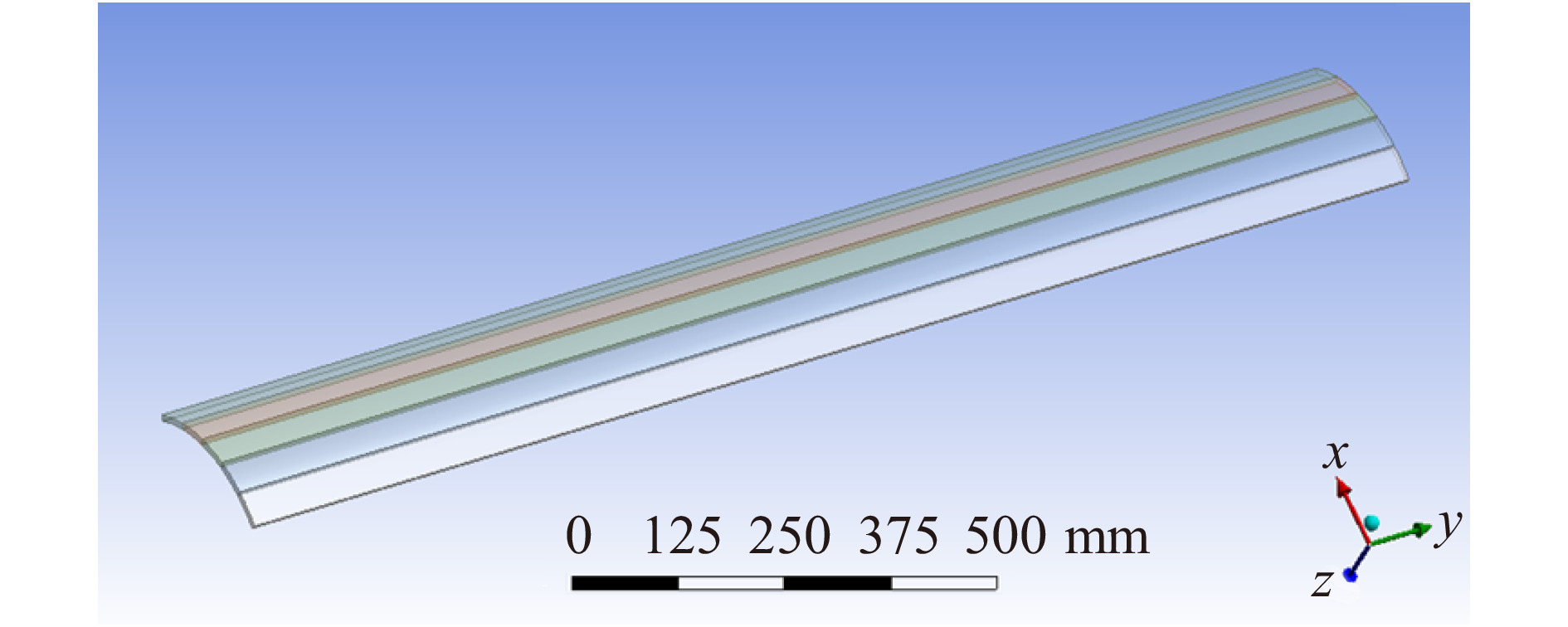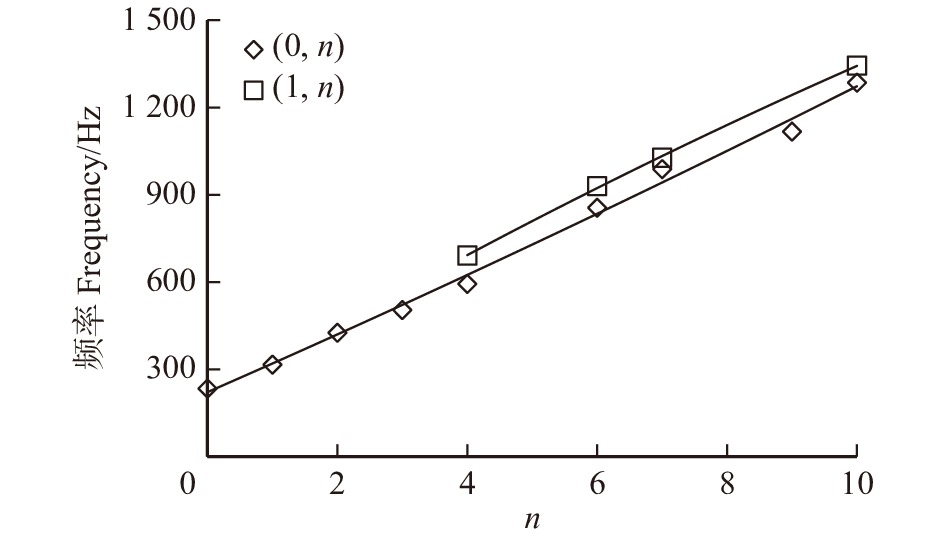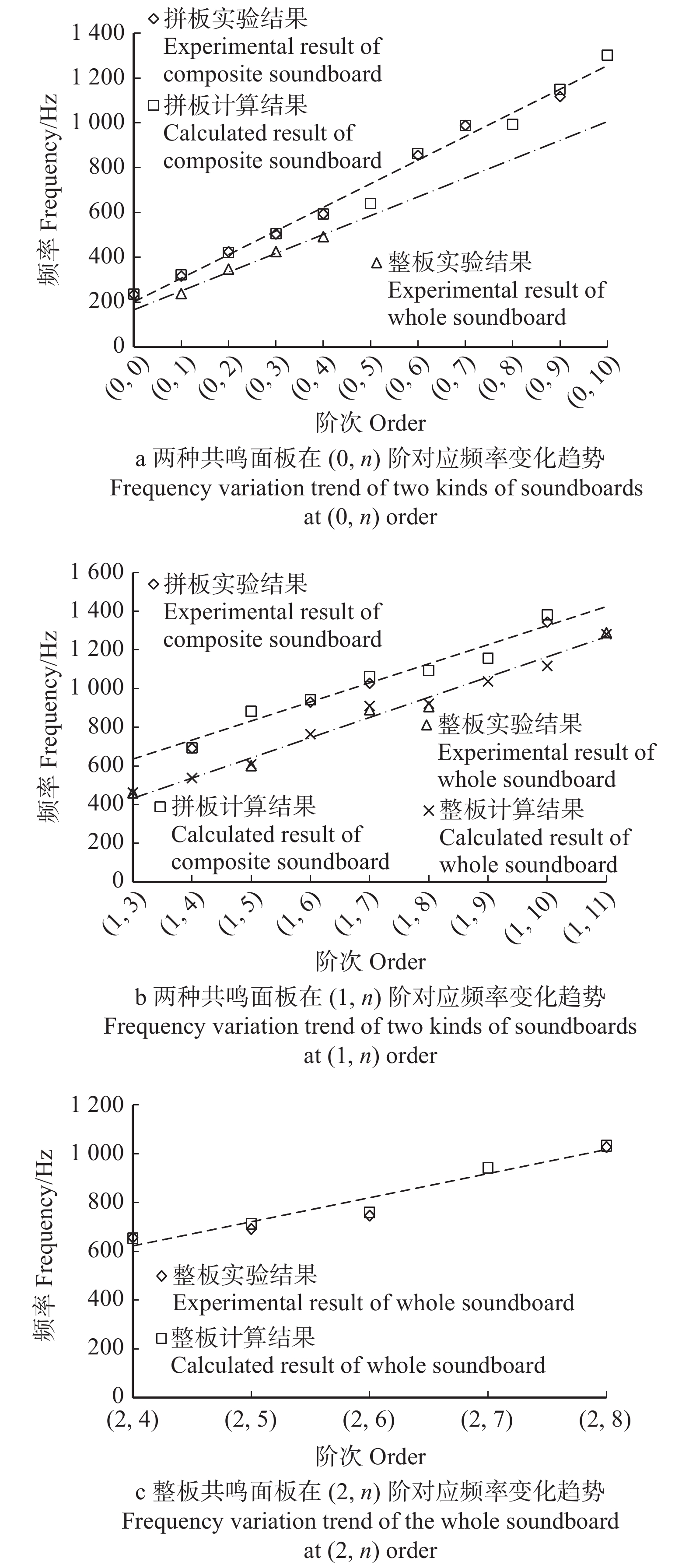Vibration mode of Guzheng soundboard with composite structure
-
摘要:目的 古筝共鸣面板的结构是影响其振动性能的重要因素之一,不同结构的共鸣面板发出的音质与音色会有所差异,迄今很少有学者就拼板古筝共鸣面板的振动发声特点展开研究。方法 本研究以拼板古筝共鸣面板为研究对象,利用两种模态分析方法探讨其声学振动性能。采用实验模态分析法,运用数字信号处理技术对采集到的激励力信号和振动响应信号进行分析,经过数据转换求得系统的频响函数,进而得出各阶次共振频率及其对应模态振型;采用计算模态分析法,建立拼板结构共鸣面板的三维模型,运用有限元法对其进行离散,通过近似方法求解出各阶次共振频率及其对应模态振型。结果 实验模态结果显示:拼板共鸣面板能够识别到的阶次有(0, n)和(1, n)阶,且多集中在(0, n)阶,(1, 4)、(1, 6)、(1, 7)和(1, 10)阶为沿横纹理方向和顺纹理方向弯曲振动叠加的复合振动,识别较困难。从振型上看,拼板共鸣面板各阶的模态振型相对清晰易识别。与实验模态结果相比,计算模态分析能够识别到选定阶次范围的所有阶次,所得振型图更加均匀且理想,而实验模态分析时个别阶次较难识别。拼板共鸣面板计算模态结果与实验模态结果呈显著的线性相关性,相关系数为0.999 6。结论 从模态分析结果来看,相对整板结构,拼板共鸣面板各阶共振频率对应的模态振型整体清晰易识别,振动频率更高;从木材利用率方面来讲,相对于制作整板,拼板共鸣面板更有利于节约木材资源。通过两种模态分析结果综合对比,验证了计算模态分析应用于拼板结构古筝共鸣面板的振动模态研究具有可行性。Abstract:Objective The structure of the Guzheng soundboard is one of the important factors affecting its vibration performance. The sound quality and tone color of the soundboards with different structures will be different. So far few scholars have studied the vibration and sound characteristics of the common structure of the composite Guzheng soundboard.Method In this study, two modal analysis methods were used to investigate the acoustic vibration performance of the composite soundboard. The experimental modal analysis method was used to analyze the collected excitation signal and the vibration response signal using digital signal processing technology. After data conversion, the frequency response function of the system was obtained, and then the resonance frequencies of each order and the corresponding modal shapes were obtained. Through using computational modal analysis, a three-dimensional model of the composite soundboard was established, discreting it by finite element method, then the resonance frequencies of each order and the corresponding mode shapes were calculated by approximate method.Result The experimental modal results showed that the (0, n) and (1, n) orders could be identified and they were mostly concentrated in (0, n). The (1, 4), (1, 6), (1, 7) and (1, 10) order were composite vibrations that bending along grain and perpendicular grain directions, and they were more difficult to identify. The modal shapes of the composite soundboard corresponding to each order frequency were clear and easy to identify. Compared with the experimental results, the computational modal analysis could identify all orders in the selected order range, and the modal shapes were more uniform and ideal. However, it was difficult to identify individual orders in the experimental modal analysis. The results of computational modal analysis showed significant linear correlation with the experimental modal results, and the correlation coefficient was 0.9996.Conclusion From the results of modal analysis, the modal shapes of the composite soundboard corresponding to each order frequency are easier and more clear to identify than the whole soundboard, and the vibration frequency is also higher. In terms of wood utilization, the composite soundboard is more conducive to saving wood resources than making the whole soundboard. Through the comprehensive comparison of the two kinds of modal analysis results, it is verified that the computational modal analysis is feasible to apply to the vibration modal analysis of the Guzheng soundboard.
-
Keywords:
- Guzheng /
- soundboard /
- vibration mode /
- finite element analysis /
- composite structure
-
树冠是衡量树木生长发育的重要指标,其结构深受自身遗传因素、年龄、林分密度、物种组成、立地条件以及施肥和间伐等森林经营管理措施相互作用、反馈调节的综合影响[1]。枝条作为树冠的基本骨架,它的大小、分布、数量和存活状态及其空间排列可以用来模拟树冠形状、反映林木之间的竞争、衡量林木在枯损中的生命力等[2-3]。此外,枝条影响光的入射和降水的截留,控制着叶面积的大小和木材的恢复潜力,为一些野生动物提供了重要的生活环境[4-5]。
现阶段人工幼中龄林在我国森林资源体系中占据主导位置,这些林分密度较大,易受病虫害爆发的影响,其林下生物多样性、森林稳定性和生态服务功能较低。而抚育间伐是目前森林经营实践中调节林分结构最有效的方法,其有助于增强林分抵御疾病和抗自然干扰能力,提高林分产量和质量[6]。为此,很多学者[7-11]利用分布函数和生物数学模型模拟不同抚育间伐强度对人工纯林中林木胸径、树高、材积和生物量等属性的影响,认为中、强度间伐可以显著提高林分平均单株直径生长量、立木材积、单株立木生物量。但以上研究都没有考虑抚育间伐对林冠生长、林下光环境、物种多样性以及进界木生长发育的影响,因此,部分学者[12-14]利用随机区组试验和生物数学模型对抚育间伐后林下物种多样性、土壤等因子进行了对比分析,发现弱度间伐并没有显著改变林下植物种类组成、灌草生物量和土壤物理性质,但改善了林下光环境,显著提高了林下进界木树高的生长。以上研究均在侧重分析抚育间伐对林分结构的影响,忽略了对林木树冠及枝条的影响。为此,Ishii和McDowell[15]首次提出枝条密度这一概念,并对不同林龄的花旗松(Pseudotsuga menziesii)枝条密度进行了模拟,发现枝条密度与树冠高度存在指数型关系。随后,Weiskittel[16]等基于前者改进的方法,利用混合模型分析了5种针叶树种之间枝条密度的变化规律,表明了种属差异对树冠结构特征变化有显著影响;Hein[17-18]等也同样采用混合模型的方法在特定的林分条件下对挪威云杉(Picea abies)和花旗松的轮枝数量进行了系统性的分析;我国学者郭孝玉[19]首次发现长白落叶松(Larix olgensis)人工林枝条密度空间分布格局呈塔形和倒“J”形,苗铮[20]和王曼霖[21]利用Possion回归分析了树木枝条数量的总体变化趋势。但他们并没有阐明枝条数量与林分经营措施之间的关系,Weiskittel[22]虽然通过模型研究了不同植被竞争、树叶病虫害管理、林分间伐及施肥管理对树冠结构的影响,但其并没有将抚育间伐效应引入到模型中,所建模型不能准确描述间伐对林木枝条的影响。
本研究基于黑龙江省林口林业局和东京城林业局不同林分条件及抚育间伐强度下的49棵人工红松(Pinus koraiensis)的树干解析和枝解析数据,以枝条密度为因变量,考虑林分抚育间伐效应,构建单水平非线性混合效应模型,旨在揭示红松人工林枝条数量与林分条件、树木大小及林分抚育间伐之间的关系,为合理控制林分密度、构建生长与收获模型以及森林经营管理措施提供理论依据。
1. 研究区概况与研究方法
1.1 研究区概况
林口林业局地处黑龙江省牡丹江市东北部,施业区跨林口、勃利和海林三县市,地理坐标为129°41′50″ ~ 130°34′20″E、45°03′29″ ~ 45°58′30″N,属于中温带大陆性季风气候。该地区海拔范围为122 ~ 1 184 m,林区年平均气温2.7 ℃,最高气温可超37 ℃,最低气温可达−39 ℃,年平均降水量580 mm。全局施业区经营总面积为273 025 hm2,森林覆盖率为80.47%,林区地势多以低山丘陵为主,植被类型主要以天然次生林、针阔混交林以及阔叶混交林为主。
东京城林业局地处黑龙江省宁安市西南部,施业区处牡丹江中上游,张广才岭东南部,全国最大的高山堰塞湖镜泊湖镶嵌在该林区内。地理坐标为128°07′45″ ~ 130°02′35″E、43°30′30″ ~ 44°18′45″N,属于中温带大陆性季风气候。该地区海拔范围为260 ~ 1 559 m,林区年平均气温3 ℃,年平均降水量550 ~ 600 mm。全局施业区经营总面积为418 468 hm2,森林覆盖率为87.55%,其中天然林蓄积占有林地蓄积的88.79%,而人工林仅为11. 21%[23]。各采样点的位置如图1所示。
1.2 数据收集与整理
为揭示抚育间伐与红松人工林枝条属性的关系,结合研究区域红松人工林资源现状,于2016年在林口林业局和东京城林业局不同立地条件(地位指数为9.15 ~ 16.19 m)、不同年龄(31 ~ 38年)的红松人工林林分中设置了29块红松人工林标准地,每块标准地面积为0.06 hm2(20 m × 30 m)。所有林分在2008年进行了第一次透光抚育,抚育间伐方式为上层透光,伐除林分上层非目的树种,以及病腐木和枯立木,同时保留具有稳定林分、生态价值明显、有培育前途的健康林木。根据其株数抚育强度设置4种作业区:(1)对照(CK),不间伐或仅作轻度卫生伐;(2)弱度间伐(L),抚育株数强度为10% ~ 20%;(3)中度间伐(M),抚育株数强度为20% ~ 30%;(4)强度间伐(H),抚育株数强度为30% ~ 40%。由于对所设置的作业区伐去部分小径阶及生长不良林木,因此,抚育蓄积强度在10% ~ 20%左右。基于各样地的年龄和优势木平均高数据,采用Logistic方程、Mitscherlich方程、Korf方程和Richards方程分别进行拟合,通过均方根误差(RMSE)和相关系数(R2)以及参数的有效性,最终确定采用Richards方程作为红松人工林的地位指数导向曲线。差分后可得计算公式如下:
SI=HT(1−e−bA0)c(1−e−bA)c (1) 式中:SI为地位指数,HT为优势木树高,A0为红松人工林的基准年龄(黑龙江地区红松人工林的基准年龄为40年),A为林分年龄,b和c为方程参数。红松人工林抚育间伐因子及林分调查因子统计量详见表1。
表 1 红松人工林抚育间伐因子及林分因子统计表Table 1. Statistics of thinning and stand factors for Pinus koraiensis planation统计量
Statistic间伐强度
Thinning intensity
(TI)/%间伐年龄/a
Thinning age
(TA)/year地位指数
Site index
(SI)/m林分平均胸径
Average stand
DBH/cm林分平均高
Mean stand
height/m林分断面积/(m2∙hm−2)
Stand basal area/
(m2∙ha−1)林分密度/(株∙hm−2)
Stand density/
(tree∙ha−1)最大值 Max. value 40.00 35.00 16.19 18.76 11.85 33.62 2 217 最小值 Min. value 0.00 28.00 9.15 11.62 6.90 12.55 716 平均值 Mean value 22.62 31.52 13.35 14.76 9.78 23.12 1 388 标准差 SD 13.26 1.53 1.65 1.83 1.31 5.27 371 变异系数 CV/% 58.64 4.84 12.38 12.40 13.37 22.79 26.72 2019年7月,分别测定29块样地中样木的胸径、树高、第一活枝高和冠幅等林木因子。根据每木检尺结果,计算各标准地平均胸径,采用等断面积径级标准木法将林木划分为五级。在不同立地条件不同抚育强度的样地中选择平均木,并在林口林业局西北楞经营所的8块样地中补充了一、三、五级不同大小的样木作为标准木,共计选取49株解析标准木。对所选标准木进行树干解析和枝条解析。由于本研究只讨论一级活枝数量与抚育间伐之间的关系,因而采用树干主轴切割分层法测定一级枝条的总着枝深度(DINC)、枝长(BL)、弦长(BCL)、基径(BD)、着枝角度(θ)等枝条属性因子,并注明存活状态。枝条密度一定程度上反映了树干分枝特征,因此,基于Ishii等[15]改进的方法,按照总着枝深度将树干从梢头到树冠基部第一活枝高处以1 m为基准划分为若干冠层,并统计每1 m区分段一级活枝的数量,即为枝条密度。本研究共获得49株红松解析木和4 370个一级枝条数据,将49 株解析木按分层抽样分为建模数据(40株,3 534个枝条)和检验数据(9株,836个枝条),红松人工林解析木的林木测定因子及枝条密度统计量信息详见表2。
表 2 红松人工林解析木和枝条分布统计表Table 2. Statistics of sample trees and branch distribution for Pinus koraiensis planation项目
Item统计量
Statistic年龄/a
Age/year胸径
DBH/cm树高
Tree height
(HT)/m冠长
Crown length
(CL)/m冠幅
Crown width
(CW)/m冠长率
Crown length
ratio (CR)枝条密度/(个∙m−1)
Branch density/
(number∙m−1)拟合数据
(样本容量 = 40)
Fitting data
(sample size = 40)最大值 Max. value 38 23.60 14.23 10.60 2.93 0.88 29 最小值 Min. value 31 8.00 7.05 4.30 1.13 0.48 1 平均值 Mean value 35.15 14.79 10.42 6.96 1.97 0.68 13.98 标准差 SD 1.53 4.60 1.79 1.34 0.45 0.11 5.20 变异系数 CV/% 4.35 31.09 17.17 19.24 22.80 16.40 37.23 检验数据
(样本容量 = 9)
Validation data
(sample size = 9)最大值 Max. value 37 25.50 13.37 8.69 3.13 0.82 31 最小值 Min. value 33 8.00 7.90 3.80 1.13 0.48 3 平均值 Mean value 34.96 16.09 10.84 7.69 2.22 0.71 14.17 标准差 SD 1.18 4.94 1.48 1.43 0.63 0.11 5.70 变异系数 CV/% 3.38 30.67 13.67 18.55 28.48 15.21 40.21 1.3 研究方法
1.3.1 冠层枝条数量方差分析
数据经Excel 2016整理后,利用R软件对不同间伐强度(TI)、不同地位指数(SI)的林木枝条数量进行描述统计和方差同质性检验,主要选取5个反映枝条数量的指标(总活枝数量、平均枝条密度、最大活枝密度、最大活枝密度的冠层深度、最大活枝密度相对冠层深度)。并采用双因素方差分析研究不同TI和SI对树冠枝条数量的垂直分布的影响。采用LSD法进行差异显著性检验,显著性水平设定为α = 0.05。
1.3.2 枝条密度基础模型
通过分析数据初步发现,冠层上部枝条发生死亡的几率较低,且受抚育间伐因子引起的枝条密度增长速率相对恒定。因此,本文基于Ishii和McDowell[15]改进的方法,即将树高按1 m分层,统计各冠层内一级活枝的数量,枝条密度(个/m)的计算公式为:
ρNB=NBjDHCj (2) 式中:
j 为某一冠层高度位置等级(0,1,2,⋯,n ),NBj 为第j 个冠层内的枝条数量,DHCj 为第j 个冠层的长度(本文中DHC为1 m)。基于(1)式,建立人工红松枝条密度的一般非线性回归模型(基础模型)时,将枝条密度由上冠到下冠的垂直变化模拟为负指数过程,基本形式如下:
ρNB=λexp(−kDINC) (3) 式中:
ρNB 为枝条密度,DINC 为总着枝深度(各枝条到树梢的距离),λ 、k 均为参数,采用非线性最小二乘法估计。然而,据Andreassen[24]、Weiskittel[1, 16]和Hein[17-18]等对道格拉斯冷杉(Pseudotsuga menziesii)、北美乔松(Pinus strobus)等几个树种枝条生长模型的研究,认为林木枝条数量不仅与着枝深度(DINC)关系密切,还与树木大小(如胸径(DBH)、树高(HT))、竞争因子(如林分前期每公顷断面积(S)、林分前期每公顷株数(N))和林分因子(如地位指数(SI)、林分间伐前期年龄(TA)、抚育间伐强度(TI))等关系显著。因此,本研究采用全部子集法[11]筛选自变量,充分考虑自变量参数检验显著性(P < 0.05),将TI与TA的比值作为一个变量加入基础模型中,以此来量化抚育间伐对因变量(
ρNB )的影响。全部子集法是筛选模型自变量的一种重要方法。它考虑模型中自变量所有可能的组合,根据特定的模型评价指标从中选出表现最优的一组。其优点是可以处理自变量多重共线性(方差膨胀因子(VIF)>10时),但在变量数量较大时(例如自变量个数远远超过10),即使是在应用计算机的情况下,也需要较高的计算量。当自变量个数较少时,该方法可以全面考虑各种情况,因此在研究中受到高度重视。
1.3.3 非线性混合模型
为考虑样地或样地内样木大小对枝条密度的随机干扰,在基础模型之上引入随机效应(即样地效应和样木效应),因此,单水平非线性混合效应模型的形式为[25]:
{yij=f(φijk,νijk)+ξij,φij=Aijχ+Bijβi,βi∼N(0,D),ξij∼N(0,σ2Ri)i=1,⋯,l;j=1,⋯,mi (4) 式中:
yij 表示第i 块样地各1 m区分段上活枝的数量;l 为样地数量;mi 为第i 个样地中连续观测的区分段个数;f 为含有参数向量φij 和预测变量向量νij 的函数;ξij 表示服从正态分布的组内误差;Aij 为(fij×p) 维已知设计矩阵;χ 为(p×1) 维固定参数向量;βi 为第i 块样地带有方差−协方差矩阵D的(q×1) 维随机效应向量;Bij 为随机效应的设计矩阵;σ2 为方差,Ri 为第i 块样地的方差−协方差矩阵;ξij 和βi 相互独立。基于建模数据,本文利用R软件nlme包中nlme()函数,采用极大似然法估计非线性混合效应模型参数。在未知协方差结构时,可将模型中所有参数看成混合效应参数,通过比较拟合统计量再从收敛的模型中选出模拟精度最高的模型。本研究采用的随机效应方差−协方差结构是无结构矩阵(UN)、对角矩阵(UN(1))和复合对称矩阵(CS)。为了进一步验证抚育间伐对枝条密度的影响,在拟合出最优混合模型后,利用其固定效应模拟不同条件下不同大小的人工红松枝条密度分布规律图,以此对比分析枝条密度随各变量变化的的差异。
1.3.4 模型评价与检验
利用独立的建模样本数据进行建模,采用调整决定系数(Ra 2)、赤池信息准则(AIC)、贝叶斯信息准则(BIC)、对数似然值(Log likelilood)等评价指标对模型拟合优度进行评价比较,对参数个数不同的模型进行似然比(LRT)检验,从而选出最优混合模型。在此基础上,为最优模型加入不同的随机效应方差−协方差结构重新拟合,采用Ra 2、均方根误差(RMSE)等评价指标选出最优方差结构。
利用独立的检验样本数据对模型的预估能力进行检验,其统计指标为平均绝对偏差(MAE)、平均相对偏差绝对值(RMAE)、模型预估精度(
Fp )等,混合效应模型检验时固定效应部分的检验与传统的检验方法相同,而随机参数检验需要二次抽样来计算随机参数值,然后计算相应统计指标。模型评价与检验统计指标计算公式如下:
调整决定系数(R2a):R2a=1−(n−1)n∑i=1(yi−ˆyi)2(n−p)n∑i=1(yi−ˉyi)2 (5) 均方根误差(RMSE):RMSE=√n∑i=1(yi−ˆyi)2n−p (6) 平均绝对偏差(MAE):MAE=n∑i=1|yi−ˆyin| (7) 平均相对偏差绝对值(RMAE):RMAE=1nn∑i=1|yi−ˆyiyi|×100% (8) 预估精度(Fp):Fp=(1−t0.05⋅Sˉyˉy)×100% (9) 式中:
yi 为实测值,ˆyi 为预测值,ˉy 为yi 的平均值,Sˉy=√∑(yi−ˆyi)2n(n−p) ,n为样本数,p为模型参数的个数。对于混合模型(4),根据经验线性无偏最优预测法(EBLUP)[26],可采用下述公式计算模型检验时的随机效应:
ˆβi=ˆDˆZTi(ˆZiˆDˆZTi+ˆRi)−1[ˉyi−f(Aˆχi,vi)] (10) 式中:
ˆβi 预测的随机效应参数,ˆD 、ˆRi 分别为随机效应参数和误差项协方差矩阵的估计,ˆZi 为混合模型(3)中因变量对各随机效应参数的偏导数组成的矩阵,ˉyi 为检验样本中第i 个样地(或样木)活枝数量的平均值,ˆχi 为模型固定效应参数的估计值,vi 为第i 个样地(或样木)中预测变量组成的矩阵。2. 结果与分析
2.1 枝条密度方差分析
通过对抚育间伐后林木的枝条数量进行间伐强度和地位指数的统计假设检验,在α = 0.05水平下,发现间伐强度、地位指数及其交互作用对枝条数量存在一定的影响,遂采用LSD法在所有的TI-SI组合间进行多重比较。双因素方差分析结果表明(表3):不同林分的林木枝条密度之间存在显著差异,其中总活枝数量在不同间伐强度、不同地位指数间有显著差异,平均活枝密度只有当间伐强度为M时不同地位指数间有显著差异,而最大活枝密度的冠层深度和最大活枝密度的相对冠层深度在间伐强度为CK和L时不同地位指数之间有显著差异,在M和H时无显著差异。在间伐强度和地位指数影响的基础上,总活枝数量和最大活枝密度的冠层深度对其交互作用也有显著响应。这可能与林分郁闭度和抚育措施有很大关系,红松人工林在幼龄阶段生长旺盛,产生了大量的嫩枝嫩芽,当林分达到郁闭后,林木树冠竞争比较激烈,冠层底部枝条生长受到自身遮阴以及与灌木层之间竞争的影响,导致树冠下层枝条大量枯死,而在此时若进行及时的抚育间伐措施会减缓枝条死亡,从而为保证单株林木生长优势提供营养物质。
表 3 不同间伐强度、不同地位指数枝条密度双因素方差分析Table 3. Two-way ANOVA of different thinning intensities and site index for branch densityTI SI n 总活枝数量
Total number of
living branch平均活枝密度/(个∙m−1)
Average density of
living branch/
(number∙m−1)最大活枝密度/(个∙m−1)
Max. density of
living branch/
(number∙m−1)最大活枝密度的冠层深度
Crown depth of
Max. branch
density/m最大活枝密度相对冠层深度
Relative crown depth of
Max. branch
density/%CK Ⅰ 6 98 ± 33abcd 14.1 ± 1.84ab 19.59 ± 1.87ab 2.76 ± 0.48bc 41.97 ± 11.50b Ⅲ 3 73 ± 21d 12.3 ± 0.63ab 16.09 ± 1.16bc 2.99 ± 0.25abc 55.27 ± 24.59ab V 3 74 ± 7cd 11.61 ± 0.35b 16.21 ± 0.21bc 4.14 ± 0.42a 70.6 ± 2.4a L Ⅲ 4 108 ± 22abc 13.9 ± 0.95ab 23.51 ± 5.64a 3.53 ± 0.79ab 49.25 ± 8.6b Ⅳ 2 72 ± 6d 11.16 ± 0.29b 16.56 ± 3.36bc 1.90 ± 0.06c 33 ± 5.23b V 2 68 ± 1d 11.39 ± 0.19b 17.08 ± 0.8bc 3.46 ± 0.77abc 56.8 ± 14.01ab M Ⅱ 10 112 ± 15ab 14.52 ± 3.06a 19.34 ± 4.1b 3.34 ± 1.04abc 44.95 ± 14.29b Ⅳ 7 97 ± 29abcd 12.03 ± 1.91b 15.9 ± 2.34c 2.99 ± 1.35abc 39.4 ± 14.89b V 2 74 ± 21cd 12.28 ± 3.5ab 17.11 ± 2.43bc 2.64 ± 0.43bc 44.35 ± 6.15b H Ⅰ 2 132 ± 5a 15.5 ± 0.68a 21.51 ± 1.54ab 2.88 ± 0.05abc 34.1 ± 0.42b Ⅱ 4 119 ± 8a 14.97 ± 0.81a 20.15 ± 0.72ab 3.44 ± 0.88abc 48.5 ± 15.41b Ⅲ 4 87 ± 34bcd 13.68 ± 2.99ab 17.44 ± 4.7bc 3.04 ± 0.29abc 50.8 ± 14.28ab 注:n.解析木株数;地位指数等级(SI):Ⅰ (15.03 ~ 16.19 m)、Ⅱ (14.01 ~ 14.81 m)、Ⅲ (13.15 ~ 13.99 m)、Ⅳ (11.94 ~ 12.91 m)、Ⅴ (9.15 ~ 11.09 m)。表中数值为平均值 ± 标准差,同一列数据后不同字母表示5%水平差异显著。Notes: n represents parse tree number; site index level (SI): Ⅰ (15.03−16.19 m), Ⅱ (14.01−14.81 m), Ⅲ (13.15−13.99 m), Ⅳ (11.94−12.91 m), Ⅴ (9.15−11.09 m). The data in table are mean ± SD. Different letters in the same column after data indicate significant differences at 5% level. 2.2 最优基础模型选取
将所有影响枝条密度的单木因子引入基础模型(3),并在方差分析的基础上,引入立地条件(地位指数)及间伐效应(抚育间伐强度、抚育间伐年龄),利用全部子集法(已将VIF > 10的自变量剔除),通过RMSE和Ra 2两个指标筛选对枝条密度有较强影响的变量,结合不同间伐条件下样地中树木枝条密度的分析结果,最终确定含有7个变量(DINC、lnRDINC、RDINC2、DBH、CL、SI、TI/TA)的模型拟合效果最佳,且所有参数均极显著(P < 0.001),其模型表达式为:
ρNB=λexp(−(k1DINC+k2lnRDINC+k3RDINC2+k4DBH+k5CL+k6SI+k7(TI/TA))) (11) 式中:
ρNB 为枝条密度,本文中指红松树干每1 m区分段上一级活枝的数量;DBH为单木胸径,cm;CL为单木冠长(树高与第一活枝高的差值),m;DINC为总着枝深度(各一级枝到树梢的距离),m;RDINC为相对着枝深度(各一级枝总着枝深度与冠长的比值);SI为地位指数,m;TI为林分抚育间伐强度(即抚育株数强度),%;TA为林分抚育间伐年龄;λ 、k1 、k2 、k3 、k4 、k5 、k6 、k7 均为模型预估参数。基于3 534个枝条建模数据的最优基础模型(11)拟合结果详见表4,其模型Ra 2 = 0.591 6,RMSE = 2.990 4。表 4 最优基础模型参数拟合结果Table 4. Fitting results of the best basic model参数 Parameter 样本容量 Sample size 估计值 Estimation 标准误差 SE t P λ 3 534 24.485 517 1.193 713 20.512 1 < 0.000 1 k1 3 534 0.155 000 0.012 954 11.965 6 < 0.000 1 k2 3 534 −0.616 205 0.017 812 −34.595 3 < 0.000 1 k3 3 534 1.279 126 0.062 997 20.304 6 < 0.000 1 k4 3 534 0.005 237 0.001 403 3.733 7 < 0.000 1 k5 3 534 −0.037 561 0.006 627 −5.667 9 < 0.000 1 k6 3 534 −0.048 652 0.003 168 −15.660 0 < 0.000 1 k7 3 534 −0.055 832 0.005 951 −9.381 7 < 0.000 1 2.3 枝条密度非线性混合模型的建立
2.3.1 枝条密度非线性混合模型拟合结果
基于最优基础模型(11),随机效应方差−协方差结构为UN时,利用R 3.6.1软件nlme包对式(11)的不同随机效应参数组合进行拟合,采用Ra 2、Log-likelihood、AIC、BIC对不同模型的拟合优度进行比较,此外,为避免过参数化问题,对不同模型进行似然比检验LRT,其中P < 0.05代表差异显著,拟合结果详见表5(本研究中仅列出相同随机效应参数个数情况中的最优模型)。
表 5 基于不同随机效应参数组合的枝条密度模型拟合精度比较Table 5. Comparison of mixed branch density model based on different random effect parameters随机效应
Random effect模型
Model随机效应参数
Random effect
parameter参数个数
Number of
parameterRa 2 AIC BIC Log-
likelihood似然比检验
Likelihood ratio
test (LRT)P 11 无 None 8 0.591 6 18 533.29 18 588.82 −9 257.64 样木效应
Sample tree effect11.1 k3 9 0.613 1 18 446.23 18 507.91 −9 213.12 89.04 < 0.001 11.2 k3、k7 11 0.629 6 18 300.37 18 374.38 −9 138.18 149.88 < 0.001 11.3 k1、k4、k5 14 0.640 2 18 245.35 18 337.87 −9 107.67 61.02 < 0.001 样地效应
Sample plot effect11.4 k5 9 0.675 0 17 910.10 17 971.78 −8 945.05 11.5 k2、k4 11 0.742 4 17 202.39 17 276.40 −8 589.19 711.72 < 0.001 11.6 k1、k2、k4 14 0.797 8 16 566.78 16 659.30 −8 268.39 641.60 < 0.001 11.7 k1、k2、k4、k7 18 0.808 2 16 316.18 16 433.37 −8 139.09 258.60 < 0.001 11.8 k1、k2、k3、k4、k7 23 0.825 7 16 125.71 16 273.74 −8 038.85 200.48 < 0.001 由表5可知,基于样木效应时,枝条密度混合模型共有44种组合收敛(本研究未全部列出),当随机参数超过3个时,模型均不收敛。随着随机参数的增加,混合模型的AIC、BIC逐渐降低,Log-likelihood值逐渐增大,说明混合模型的拟合效果均优于基础模型(11),其中以参数
k1 、k4 、k5 同时作为随机效应参数模型(11.3)的AIC、BIC最小,Log-likelihood值最大,Ra 2较基础模型提高了8.21%,拟合效果最佳。LRT 检验表明:基础模型(11)与模型(11.1)、模型(11.1)与模型(11.2)、模型(11.2)与模型(11.3)之间差异均极显著(P < 0.001),因此,将模型(11.3)作为基于样木效应的枝条密度最优混合模型。基于样地效应时,枝条密度混合模型共有67种组合收敛(本研究未全部列出),且由于模型(11)参数较多,当随机参数超过5个时,模型均不收敛。随着随机参数的增加,混合模型的AIC、BIC相对于基本模型(11)以及基于样木效应的混合模型(模型11.1、模型11.2、模型11.3)均有一定程度的降低,而Log-likelihood 均有一定幅度的提高,说明基于样地效应的混合模型优于基础模型和基于样木效应的混合模型。其中以参数
k1 、k2 、k3 、k4 、k7 同时作为随机效应参数模型(11.8)拟合效果最佳,AIC较模型(11)和模型(11.3)分别降低了13.00%、11.62%,BIC较模型(11)和模型(11.3)分别降低了12.45%、11.26%,Log-likelihood值较模型(11)和模型(11.3)分别提高了13.17%、11.74%,而Ra 2较模型(11)和模型(11.3)分别提高了39.57%、28.98%。LRT 检验表明:模型(11.4)与模型(11.5)、模型(11.5)与模型(11.6)、模型(11.6)与模型(11.7)、模型(11.7)与模型(11.8)之间差异均极显著(P < 0.01),说明模型(11.8)优于其他模型。随机效应方差−协方差结构可以反映树木间的差异性。本研究采用无结构矩阵(UN)、对角矩阵(UN(1))和复合对称矩阵(CS)对比分析发现,无论是基于样木效应还是基于样地效应的最优非线性混合模型,CS均不收敛,而UN始终显示出最好的拟合效果。综上分析,最终将含有UN基于样地效应的模型(11.8)作为模拟枝条密度的最优混合模型(即模型(11.8),Ra 2 = 0.825 7)。枝条密度最优基础模型和最优混合模型的固定参数、随机参数的拟合统计量详见表6。
表 6 不同参数数量模型方差组成、参数估计及拟合统计量Table 6. Variance component, fixed parameters and fitting statistic estimates of models with different numbers of parameters项目 Item 参数 Parameter 模型11 Model 11 模型11.3 Model 11.3 模型11.8 Model 11.8 固定效应参数
Fixed effect parameterλ 24.485 5*** 25.595 1*** 22.221 1** k1 0.155 0*** 0.229 0*** 0.157 7 k2 −0.616 2*** −0.701 5*** −0.656 9*** k3 1.279 1*** 1.019 4*** 1.598 9*** k4 0.005 2*** −0.020 7** 0.001 7 k5 −0.037 6*** −0.060 6*** −0.100 8*** k6 −0.048 7*** −0.026 7*** −0.050 1* k7 −0.055 8*** −0.002 7 −0.350 5* 随机效应方差−协方差结构
Variance of random effect-covariance structureσ2k1 0.050 5 0.207 6 σ2k2 − 0.183 8 σ2k3 − 0.886 5 σ2k4 0.016 0 0.048 3 σ2k5 0.046 3 − σ2k7 − 0.313 3 σ2k1k2 − −0.915 0 σ2k1k3 − −0.936 0 σ2k1k4 0.105 0 −0.911 0 σ2k1k5 −0.580 0 − σ2k1k7 − 0.119 0 σ2k2k3 − 0.789 0 σ2k2k4 − 0.843 0 σ2k2k7 − 0.013 0 σ2k3k4 − 0.798 0 σ2k3k7 − −0.085 0 σ2k4k5 −0.791 0 − σ2k4k7 − −0.471 0 拟合统计量
Fitting statisticsR2a 0.591 6 0.640 2 0.825 7 RMSE 2.990 4 3.120 7 2.171 4 注:***表示在P < 0.001水平上显著,**表示P < 0.01水平上显著,*表示P < 0.05水平上显著。Notes: *** represents significiance at P < 0.001 level; ** represents significiance P < 0.01 level; * represents significiance at P < 0.05 level. 2.3.2 误差项方差−协方差结构的确定
利用最优混合模型拟合枝条密度时,考虑到树木内误差项方差−协方差结构,本研究采用林业上常用的一阶自回归结构AR(1)、一阶自回归与移动平均结构ARMA(1,1)和复合对称结构CS来描述树木内枝条的空间序列相关性,但模型拟合均不收敛。由于枝条数据不是连续观测数据,因此本文可以不考虑枝条密度模型的时间相关性。
2.4 模型评价与检验
最优基础模型和最优混合模型拟合残差图见图2,可以看出,两个模型残差分布均匀且未出现异方差性,其中残差图2B明显优于残差图2A,说明混合效应模型拟合效果明显优于基础模型。
基于独立的检验样本数据,计算出检验数据的随机效应参数和预测值,从而对最优基础模型和最优混合效应模型进行检验(表7)。结果表明:基础模型在引入随机参数后,其预估精度(Fp)有所提高,平均绝对偏差(MAE)、平均相对偏差绝对值(RMAE)有所下降,说明混合效应模型检验结果优于基础模型。
表 7 最优基础模型与最优混合模型检验结果Table 7. Validation results of the best basic model and the best mixed-effects model模型 Model 样本容量 Sample size 平均绝对偏差 MAE 平均相对偏差绝对值 RMAE 预估精度 Fp 基础模型11 Basic model 11 836 4.099 9 39.86 97.376 4 混合模型11.8 Mixed model 11.8 836 2.465 4 20.86 98.553 5 2.5 基于最优混合模型枝条密度分布规律模拟
本研究基于枝条密度最优混合模型(11.8)的固定效应,分别模拟了不同条件下不同大小的人工红松枝条密度随RDINC变化的分布规律,模拟方法是固定其中的3个变量(趋近平均值),从而模拟枝条密度与剩余变量(其中变量DINC、lnRDINC、RDINC2是可变的)的变化规律。由图3可知,枝条密度随RDINC的增大呈先增大后减小的趋势,其中不同间伐强度、不同地位指数、不同间伐年龄和不同等级木均在树冠上部RDINC = 0.310 98时枝条密度达到峰值,且在冠层下部三分之二的部位活枝数量越来越少,活枝数量总体分布在树冠中上层,这可以为林分确定间伐强度提供一定的参考依据。由图3A可知,在树木DBH、CL、SI保持不变时,枝条密度随着TI增加呈明显增大的趋势,且在TI达到H时达到最大值,这说明在其他变量保持不变的情况下,抚育间伐强度越大,枝条密度越大。由图3B可知,在DBH、CL、TI/TA保持不变时,枝条密度随着SI增加呈增大的趋势,且地位指数越高,枝条密度越大,这说明立地条件对枝条生长有较强的影响。相对于间伐强度,TA对枝条密度影响较小(图3C),且呈相反趋势,即枝条密度随着TA的增加而减小,但变化不明显,说明在林分年龄较大时采取抚育间伐措施不利于枝条生长。由图3D可知,不同等级木冠层内的枝条密度差异不明显,枝条密度随着胸径的增大而减小,这与模型(11.8)中参数DBH不显著(P = 0.94)结果相一致。而在树冠的中上部,CL越大的树木,枝条密度越大(图3E),当CL为4、6、8、10 m分别在RDINC为0.365、0.329、0.297、0.269处达到峰值,这表明在其他变量保持不变的情况下,枝条密度有明显的向树梢方向移动的趋势;在树冠的中下部,4种冠长在RDINC = 0.639 2处交于一点,且枝条密度与树冠中上部呈相反趋势,即冠长较大的树木在树冠的中上部有更多的活枝,而冠长较小的树木在树冠的中下部有更多的活枝。
3. 结论与讨论
本研究基于不同林分条件及抚育间伐强度的49 棵人工红松解析木和枝解析数据,将林分抚育间伐效应引入模型中,采用非线性混合模型的方法建立了红松人工林枝条密度混合模型,并利用Ra 2、AIC、BIC、Log-likelihood 及LRT检验评价不同混合模型的效果。结果表明:
(1)随机效应的引入和无结构(UN)方差−协方差矩阵均能提高基础模型的拟合优度。当考虑样木效应时,以
k1 、k4 、k5 同时作为随机效应参数模型(11.3)的拟合效果最佳,Ra 2较基础模型提高了8.21%;考虑样地效应时,以k1 、k2 、k3 、k4 、k7 同时作为随机效应参数模型(11.8)的拟合效果最佳,Ra 2较基础模型提高了39.57%。无论考虑样木效应还是样地效应,混合模型的模拟精度较基础模型均有大幅度的提升,且通过各项拟合指标和残差异质性检验均可以说明基于样地效应的混合效应模型比基础模型能更好地模拟枝条密度的变化,且引入抚育间伐因子,所建模型更能精准描述枝条密度随林分发育的变化规律,具有一定的生物学意义和统计可靠性。(2)利用最优混合模型的固定效应参数,分别模拟了不同条件下枝条密度随RDINC变化的分布规律。当地位指数和树木等级相近时,抚育间伐强度和冠长越大,枝条密度越大,且差异明显;随着间伐年龄的增大,枝条密度略有下降的趋势;当抚育间伐强度和树木等级相近时,地位指数和冠长越大,枝条密度越大;而抚育间伐强度和地位指数相近时,树木胸径越大,枝条密度反而越小,这可能是林分经过抚育间伐后枝条受气候、光照和立地条件的影响,会加快基径生长,从而淘汰部分竞争能力相对较弱的枝条,这与前人的研究相一致[15]。
林分条件决定了枝条的生长与死亡,Ishiia等[15]和Weiskittel等[16]认为可将枝条密度看作其从开始萌发到死亡的函数,一般从树梢到树冠基部呈指数型下降趋势,本研究结果与其趋同。在此之前,Weiskittel等[27]证明了施肥和间伐对树冠衰退率有显著影响,但是这一过程在枝条层面几乎没有得到验证。随后,Weiskittel等[22]、Thorpe等[28]及Sattler等[29]研究发现枝条对经营措施所造成的林分条件及其局部立地竞争机制的变化具有较强的响应能力,并以此解释了树木和林分生长响应的重要机制。本研究基于前者枝条模型的优点,将林分经营措施(抚育间伐)作为变量引入模型,对其进行进一步优化,使其更加符合红松人工林枝条的生长特点。从森林资源调查经验来看,林分发育初期树冠上部轮生幼枝产生大量的叶芽,为其生长发育提供了充足的碳水化合物,使林分的遮荫作用逐渐增强。随着林分郁闭度的增加,树冠上部三分之二的枝条生长旺盛,而冠层下部三分之一的枝条长期无法进行正常光合作用,累积的负能量消耗了大量的养分,从而导致了其死亡[30]。若此时进行合理的抚育间伐措施,不但能减缓枝条死亡的速率,还能增强其光合潜力,有利于增强林分生长发育和材种出材率。因此,基于抚育间伐效应的生物数学模型,能够更加准确地体现抚育间伐对林木枝条产生的影响,为制定更加科学合理的间伐体制提供基础。
-
表 1 拼板共鸣面板的尺寸规格
Table 1 Geometric parameters of the composite soundboard
mm 长度 Length 宽度
Width厚度 Thickness 弧圆半径
Arc radius横向弧长
Transverse arc length首部 Head 尾部
Tail宽度方向
Width direction长度方向
Length direction首部
Head尾部
Tail1 630 350 295 7 330 7 300 368 311 表 2 共鸣面板模态分析的材性参数
Table 2 Mechanical properties for modal analysis of soundboard
密度
Density (ρ)/(kg·m−3)杨氏模量
Young’s modulus/MPa剪切模量
Shear modulus/MPa泊松比
Poisson’s ratioEL ET ER GLT GLR GRT μLT μLR μRT 260 6 200 1 030 2 960 300 200 33 0.15 0.02 0.08 注:表中剪切模量、泊松比的数据取自参考文献[18]。EL、ET和ER分别为顺纹、弦向和径向的杨氏模量,GLT、GLR和GRT分别为弦向、径向和横纹的剪切模量。μLT、μLR和μRT分别为纵弦向、纵径向、径弦向的泊松比。Notes: data of the shear modulus and Poisson’s ratio in the table are cited from reference [18]. EL, ET and ER are Young’s modulus along grain, tangential and radial direction, respectively. GLT, GLR and GRT are shear modulus along tangential, radial and perpendicular grain direction, respectively. μLT, μLR and μRT are Poisson’s ratios along longitudinal versus tangential, longitudinal versus radial and radial versus tangential direction, respectively. 表 3 计算模态分析与实验所得各阶频率对比
Table 3 Frequency comparison between computational modal analysis and experimental results
阶次
Order频率 Frequency/Hz 误差 Error/% 阶次
Order频率 Frequency/Hz 误差
Error/%实验结果
Experimental result计算结果
Calculated result实验结果
Experimental result计算结果
Calculated result(0, 0) 234.38 235.42 0.47 (0, 9) 1 117.19 1 150.10 2.94 (0, 1) 316.41 321.66 1.66 (0, 10) 1 285.16 1 301.60 1.28 (0, 2) 424.78 420.77 −0.94 (1, 4) 691.41 693.06 0.24 (0, 3) 503.91 506.02 0.42 (1, 5) 882.34 (0, 4) 593.75 593.47 −0.05 (1, 6) 929.69 941.87 1.31 (0, 5) 639.45 (1, 7) 1 027.34 1 061.90 3.36 (0, 6) 855.47 863.13 0.90 (1, 8) 1 092.40 (0, 7) 988.28 988.14 −0.01 (1, 9) 1 157.00 (0, 8) 993.55 (1, 10) 1 343.75 1 379.80 2.68 表 4 两种结构古筝共鸣面板的各阶次对应频率比较
Table 4 Frequency comparison of the two structures of Guzheng soundboards at different orders
阶次
Order频率 Frequency/Hz 阶次
Order频率 Frequency/Hz 拼板
Composite board整板
Whole board拼板
Composite board整板
Whole board(0, 0) 234.38 (1, 5) 601.56 (0, 1) 316.41 238.28 (1, 6) 929.69 (0, 2) 425.78 347.66 (1, 7) 1 027.34 890.63 (0, 3) 503.91 425.78 (1, 8) 906.25 (0, 4) 593.75 492.19 (1, 10) 1 343.75 (0, 6) 855.47 (1, 11) 1 289.06 (0, 7) 988.28 (2, 4) 656.25 (0, 9) 1 117.19 (2, 5) 691.41 (0, 10) 1 285.16 (2, 6) 746.09 (1, 3) 460.94 (2, 8) 1 027.34 (1, 4) 691.41 -
[1] 葛颖, 张元婷, 万珂, 等. 整板结构的古筝共鸣面板振动模态的研究[J]. 北京林业大学学报, 2021, 43(8): 107−116. doi: 10.12171/j.1000-1522.20210136 Ge Y, Zhang Y T, Wan K, et al. Vibration mode of Guzheng resonance panel with whole board structure[J]. Journal of Beijing Forestry University, 2021, 43(8): 107−116. doi: 10.12171/j.1000-1522.20210136
[2] 李坚, 甘文涛, 王立娟. 木材仿生智能材料研究进展[J]. 木材科学与技术, 2021, 35(4): 1−14. Li J, Gan W T, Wang L J. Research progress on wood biomimetic intelligent materials[J]. Chinese Journal of Wood Science and Technology, 2021, 35(4): 1−14.
[3] 嵇建书, 裴永超, 罗敏, 等. 古筝琴板的振动特性初探研究[J]. 林产工业, 2021, 58(6): 34−40. Ji J S, Pei Y C, Luo M, et al. Preliminary study on the vibration characteristics of Guzheng board[J]. China Forest Products Industry, 2021, 58(6): 34−40.
[4] 王仲林, 樊文博, 蔡旻宇, 等. 古筝的结构、原理及设计建模[J]. 东华大学学报(自然科学版), 2012, 38(5): 564−571. Wang Z L, Fan W B, Cai M Y, et al. The structure, principle and design modeling of Zheng[J]. Journal of Donghua University (Naturual Science), 2012, 38(5): 564−571.
[5] 陈积敏. 我国木材进口贸易安全治理策略探讨[J]. 林产工业, 2020, 57(12): 50−54. Chen J M. Discussion on China’s governance strategies for security of timber import[J]. China Forest Products Industry, 2020, 57(12): 50−54.
[6] 余征跃, 邓小伟, 姚卫平, 等. 从力学角度研究中国传统民族乐器[J]. 电声技术, 2017, 41(11/12): 74−79. Yu Z Y, Deng X W, Yao W P, et al. Study on Chinese traditional musical instruments from the perspective of mechanics[J]. Audio Engineering, 2017, 41(11/12): 74−79.
[7] 雷福娟, 黄腾华, 陈桂丹. 音板声学品质的主要影响因子及其评测方法[J]. 陕西林业科技, 2017, 225(5): 85−89, 94. doi: 10.3969/j.issn.1001-2117.2017.05.021 Lei F J, Huang T H, Chen G D. The main factors affecting acoustic quality of soundboard and the methods to evaluate the acoustic quality of soundboard[J]. Shaanxi Forestry Science and Technology, 2017, 225(5): 85−89, 94. doi: 10.3969/j.issn.1001-2117.2017.05.021
[8] 孟诗语, 黄英来, 赵鹏, 等. 卷积神经网络用于近红外光谱古筝面板木材分级[J]. 光谱学与光谱分析, 2020, 40(1): 284−289. Meng S Y, Huang Y L, Zhao P, et al. Wood quality of Chinese zither panels based on convolutional neural network and near-infrared spectroscopy[J]. Spectroscopy and Spectral Analysis, 2020, 40(1): 284−289.
[9] 黄英来. 几种典型民族乐器木质共鸣体的声学振动性能检测与分析[D]. 哈尔滨: 东北林业大学, 2013. Huang Y L. Acoustic vibration performance detection and analysis of several typical folk instruments wooden resonators[D]. Harbin: Northeast Forestry University, 2013.
[10] Gough C. The violin: Chladni patterns, plates, shells and sounds[J]. The European Physical Journal Special Topics, 2007, 145(1): 77−101. doi: 10.1140/epjst/e2007-00149-0
[11] Nicholas N C, Gruber C, Hartman N. Optimization of acoustic soundboard through modal analysis and material selection[D]. Akron: The University of Akron, 2017.
[12] Klimova H, Tippner J. Modal analysis of soundboard of the upright piano by finite element method (FEM)[J]. Wood Research, 2014, 59(1): 123−135.
[13] Pedrammehr S, Aghdam N J, Pakzad S, et al. A study on vibration of Setar: stringed Persian musical instrument[J]. Journal of Vibroengineering, 2018, 20(7): 2680−2689. doi: 10.21595/jve.2018.19505
[14] 郑清铭, 左付山, 朱泳旭, 等. 基于模态分析的永磁同步电机振动研究[J]. 森林工程, 2019, 35(5): 76−81. doi: 10.3969/j.issn.1006-8023.2019.05.013 Zheng Q M, Zuo F S, Zhu Y X, et al. Research on vibration of permanent magnet synchronous motor based on modal analysis[J]. Forest Engineering, 2019, 35(5): 76−81. doi: 10.3969/j.issn.1006-8023.2019.05.013
[15] 丁源. ABAQUS6.14 中文版有限元分析从入门到精通[M]. 北京: 清华大学出版社, 2016. Ding Y. ABAQUS6.14 Chinese version of finite element analysis from entry to master[M]. Beijing: Tsinghua University Press, 2016.
[16] 俞明功, 孙德林, 邹伟华, 等. 基于ANSYS的新中式实木椅力学分析[J]. 林业工程学报, 2021, 6(3): 178−184. Yu M G, Sun D L, Zou W H, et al. Mechanical analysis of new Chinese style wood chairs using ANSYS[J]. Journal of Forestry Engineering, 2021, 6(3): 178−184.
[17] Russell S, Madden N. An introduction to the analysis and implementation of sparse grid finite element methods[J]. Computational Methods in Applied Mathematics, 2017, 17(2): 299−322. doi: 10.1515/cmam-2016-0042
[18] 杨帆. 古琴振动体与共鸣体声学特性研究[M]. 北京: 中央音乐学院出版社, 2015. Yang F. Research on acoustic vibration properties of Guqin oscillating body and resonance body[M]. Beijing: Central Conservatory of Music Press, 2015.
[19] 刘镇波, 李司单, 刘一星, 等. 琵琶共鸣面板的振动模态分析[J]. 北京林业大学学报, 2012, 34(2): 125−132. Liu Z B, Li S D, Liu Y X, et al. Vibration modal analysis of resonance board of Pi-pa[J]. Journal of Beijing Forestry University, 2012, 34(2): 125−132.
[20] 林欢, 许林云, 宣言, 等. 基于有限元的多级Y型银杏树模态分析与试验[J]. 林业工程学报, 2020, 5(1): 148−155. Lin H, Xu L Y, Xuan Y, et al. Modal analysis and experimental study of the multistage Y-type ginkgo tree using the finite element method[J]. Journal of Forestry Engineering, 2020, 5(1): 148−155.
[21] Huang J, Patil K, Baqersad J, et al. Extracting vibration characteristics of a guitar using finite element, modal analysis, and digital image correlation techniques[J]. Journal of the Acoustical Society of America, 2016, 140(4): 3211−3212.
[22] Corradi R, Miccoli S, Squicciarini G, et al. Modal analysis of a grand piano soundboard at successive manufacturing stages[J]. Applied Acoustics, 2017, 125(10): 113−127.




 下载:
下载:
































































































